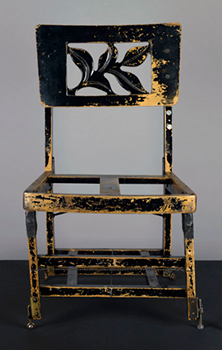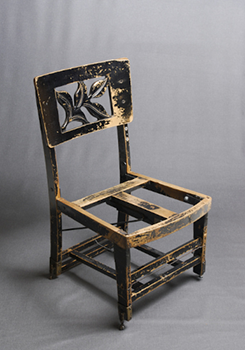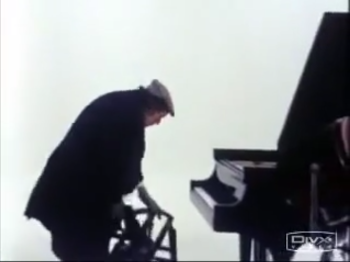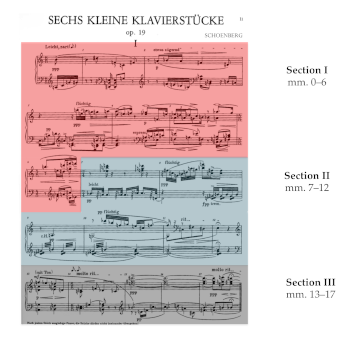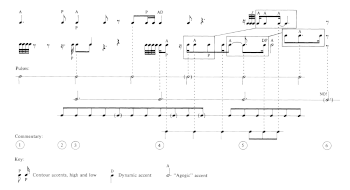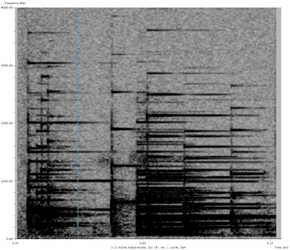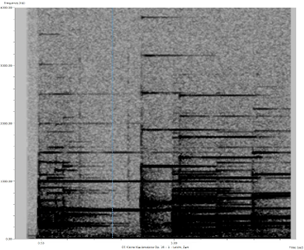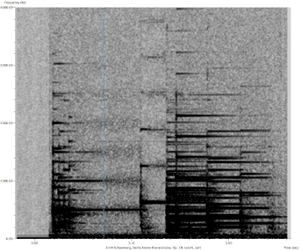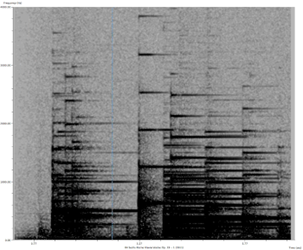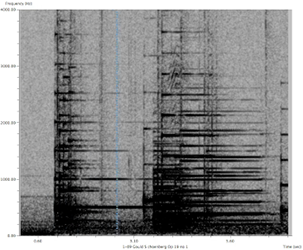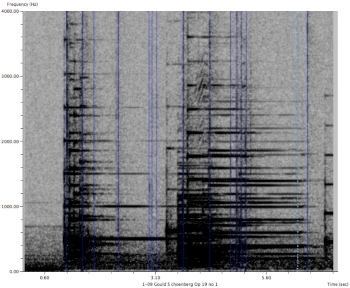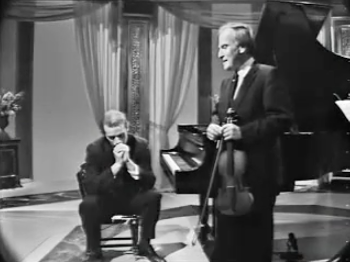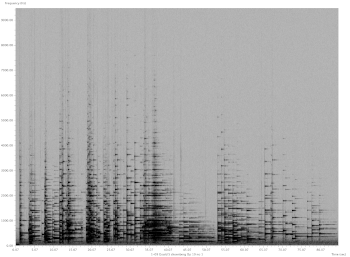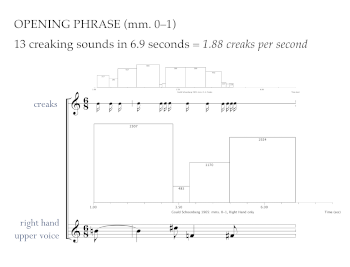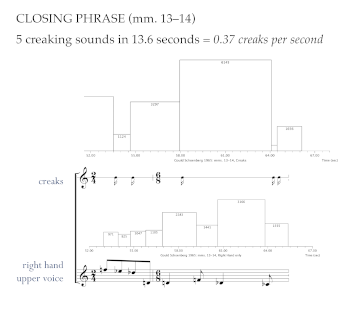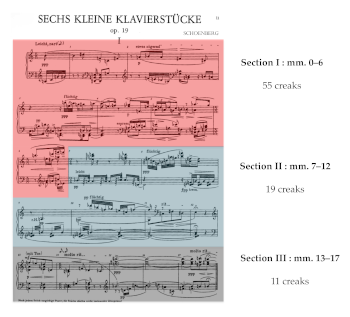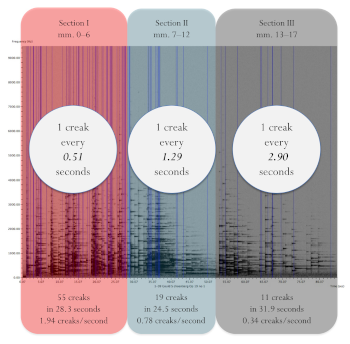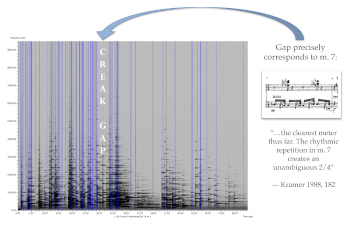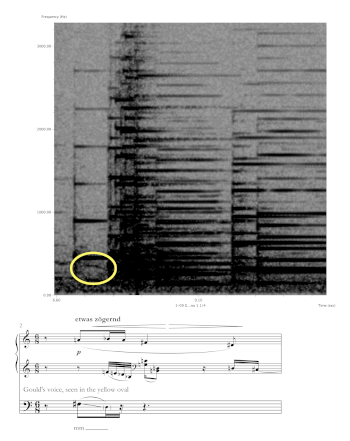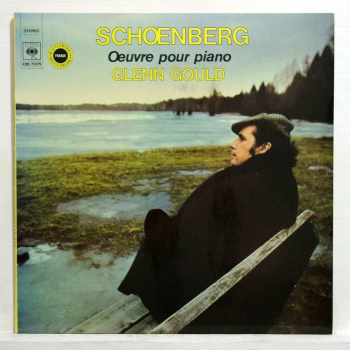Gould’s Creaking Chair, Schoenberg’s Metric Clarity*
Richard Beaudoin
KEYWORDS: rhythm, meter, microtiming, spectrogram, recording, noise, Schoenberg, Glenn Gould
ABSTRACT: The audible creaking of Glenn Gould’s loose-jointed piano chair has historically been the subject of apologetic liner notes and recording studio memoirs. These chair creaks are here recognized as “sounded movements” of Gould’s body. This article triangulates the score of Schoenberg’s Sechs kleine Klavierstücke, op. 19, no. 1, published analyses of its unique rhythmic unfolding, and new micro-temporal measurements of Gould’s September 1965 recording of the work. Quantifying Sanden’s concept of “corporeal liveness,” spectrographic tools are used to generate a proper census of all the sounds captured by the microphone in order to map their rhythmic interaction. A notable “creak gap” in Gould’s recording is linked to published observations regarding the work’s process of emerging metric clarity, and one of Gould’s vocal elaborations is recognized for its augmentation of Schoenberg’s pitch material. Overlaying analytical literature with microtiming data reveals a correlation between the composition’s trajectory of metric clarification and the decrease in Gould’s physical motion. The findings are used to question the pervasive and disturbing suppression of non-notated sounds that accompany the recording of notated music. Recognizing sounds that are normally marginalized, this study fuses theoretical observations about Schoenberg’s composition with the audio artifacts of Gould’s corporeality.
DOI: 10.30535/mto.27.1.1
Copyright © 2021 Society for Music Theory
1. “Instruments (and humans) are noisy things”
[1.1] Glenn Gould’s recordings are replete with sounds that do not appear in the scores of the works that he is performing. Such sounds range from his infamous singing to the creaking, cracking, and clicking sounds made by his loose-jointed piano chair (Bazzana 2004; Sanden 2009). Public opinion of these sounds has ranged from infatuation to annoyance; however, when the recordings were originally released, their status was precisely characterized. On the back cover of Gould’s 1965 album of Beethoven’s op. 10 sonatas, the producer Thomas Frost wrote explicitly about Gould’s chair and its sound-making tendencies. The passage deserves to be quoted at length, representing as it does the tacitly accepted viewpoint of many listeners and theorists, and opening several avenues for this inquiry:
For some years now, Gould has been merrily fugueing [sic] his way through the keyboard works of Bach, Beethoven and Schoenberg to the accompaniment of the strange creakings and groanings of an old, beloved friend—his piano stool. This object of endearment, decrepit and moth-eaten as it is (having reached retirement age long ago), apparently has learned to swing and sway so perfectly with Glenn Gould's body motions that he has stubbornly refused to part with it in spite of all counsel and advice—and an offer from the Smithsonian Institution. It has come to this: Columbia Records has decided to call upon the powers of science to construct a facsimile of the famous chair which will have the same swayability without the noise. Until then: Glenn Gould refuses to give up his chair. Columbia Records refuses to give up Glenn Gould. And we hope that you, the consumer, will refuse to be discomforted by some audible creaks that are insignificant in light of the great music-making on this disc. (Frost 1965, italics added)
Frost deems the audible creaks of Gould’s chair “insignificant” and his rhetorical construction consciously separates them from the “great music-making” that he otherwise celebrates. He explicitly requests the listener (whom he tellingly refers to as “the consumer”) do the same.
[1.2] Is Frost’s distinction a useful one? What is gained and lost when we prioritize notated sounds over non-notated vocalizations and body movements? Invoking Paul Sanden’s writings on “corporeal liveness,” the following analysis proposes that sounds produced by the interaction between the performer’s body and instrument be counted as expressive musical material. Reversing Frost’s distinction: what if listeners are not at all discomforted by such sounds, and instead are energized and fascinated by them? Music lovers and critics alike have long confessed that some of their favorite moments in the recorded literature are, for example, Arturo Toscanini’s humming (Platt 2017), Pablo Casals’ grunting (Davis 1960), and Gould’s singing (Service 2012). Acknowledging the expressivity of non-notated sounds, Jennifer Judkins writes: “Musical sounds are generated through rhythmic physical motions or air pressure applied to an instrument, and instruments (and humans) are noisy things” (2014, 14). The following analysis makes a careful accounting of the audible events in Gould’s recording of the first of Schoenberg’s Sechs Kleine Klavierstücke, op. 19, including and especially the creaking of his chair. In doing so, it accepts the sounds as they are, and collapses Frost’s separation between “insignificant” sounds and “great music-making.” Without over-glorifying such sounds, this analysis recognizes and measures the interaction between the sounds notated in Schoenberg’s score and those created by Gould’s body as he records the work. This article argues for the equality of all of the sounds captured by the microphone when Gould recorded Schoenberg’s op. 19, no. 1 at Columbia’s 30th Street Studios on the 28th or 29th of September 1965, and which appear on the commercial recording released that same year.
[1.3] To avoid any self-serving correlation between events in Schoenberg’s score and the audible traces of Gould’s body motions, newly-collected spectrographic rhythmic measurements will be superimposed upon established published analyses of the work, principally those by Jonathan Kramer (1988), Charles Morrison (1992), and John Roeder (1994). Schoenberg’s work, as it happens, exhibits a unique process that Kramer calls “the emergence of foregrounded meter” (1988, 181). The unfolding of this process within Schoenberg’s work will be understood in relation to all the sounds on Gould’s recording, including and especially the creaking sounds made by the piano chair. Along these lines, this article is not claiming a broad conclusion about Gould’s general pianism, but rather identifies a non-trivial correlation between sounds made by Gould’s body motions during a single recording and a recognized formal trajectory within the work that he is playing.(1) Overlaying earlier analytical literature on Schoenberg’s use of meter with this new microtiming data reveals a correlation between the composition’s trajectory of metric clarification and Gould’s physical motion. The overall findings can be summarized as follows: there is a marked decrease in the sounds made by Gould’s chair that coincides with a gradual clarification of meter across Schoenberg’s work. This article resists applying such findings any more widely than they deserve. Too often in performance and recording analysis, a finding in one case is used to substantiate a larger claim across other cases, whether within the oeuvre of a single pianist, or across generations of pianists. Resisting over-extrapolation, this is an investigation of a recording as a recording, and not an argument about a generalized performance practice. Expanding upon Nicholas Cook’s recommendation that scholars “exploit the potential of sound recordings as documents” (2009, 776), the following close reading uses the example of Gould’s recording of Schoenberg’s op. 19, no. 1 as a case study of the interaction between notated and non-notated sounds.
2. Micro-Expressions and the Punctum
[2.1] In advocating for the expressive content of Gould’s chair sounds, two analogies prove useful: the psychological category of micro-expressions and the philosophical category of the punctum. Within the field of psychology, the topic of micro-expressions originated with the work of Ernest Haggard and Kenneth Isaacs (1966) and was later popularized by a series of books by Paul Ekman. Micro-expressions, and the related categories of slight and partial expressions, are the facial gestures that we unconsciously witness, or make, when listening or speaking (Ekman 2003). These rapid facial motions deliver crucial information that would not be recorded in a written transcript of a given conversation. Gould’s chair creaks fall into a similar category of sounds that we might overlook (or “listen past”), but that we nonetheless hear. Just as facial micro-expressions offer valuable and often revealing information that enhances the meaning of spoken words, the placement and density of Gould’s chair creaks provide audio signals of physical activity. As such, they are integral to our interpretation of his interpretation.
[2.2] Roland Barthes’s celebrated concept of the punctum arises in Camera Lucida, his 1980 essay on photography. While looking at photographs, Barthes contrasts the “studium”—the term he invokes to define the factual contents of the photograph, or what the picture is of—with the “punctum,” which is the small detail that somehow disturbs the studium. He writes that “the punctum is also: string, speck, cut, little hole—and also a cast of the dice. A photograph’s punctum is that accident which pricks me (but also bruises me, is poignant to me)” (1980, 27). As reminders of his physicality and effort, the sounds made by Gould’s body, including his singing and the creaking of his piano chair, are classic puncta. They provide glimpses of the corporeality of a performative moment, the sense of the pianist at the piano.
[2.3] Transposing the punctum from photographs to audio recordings reveals differences in each medium’s experiential temporality. Barthes is able to isolate precisely which aspect of a photograph operates as a punctum: a woman’s “strapped pumps” in James Van der Zee’s Family Portrait (1980, 43–4) or a child’s “bad teeth” in William Klein’s Little Italy, New York (1980, 45–6). Gould’s chair creaks do not occur at a single moment in time but are spread (unequally) across an entire track. As audio evidence of Gould’s corporeality, these non-notated sounds inspire many of the same (often contradictory) reactions that Barthes experiences while looking at photographs: the chair creaks annoy, disturb, and break cultural agreements, while at the same time arousing sympathy, fascination, and a sense of intimate connection. As such, these sounds are exemplary audio puncta. Seen in this light, the whole of Gould’s oeuvre presents one of the most punctum-rich corpuses in the history of recorded music. Barthes’s final pronouncement on the punctum also carries over to Gould’s non-notated sounds: “Last thing about the punctum: whether or not it is triggered, it is an addition: it is what I add to the photograph and what is nonetheless already there” (1980, 55). The audible creaks of Gould’s chair are an addition to the work that he is recording; these sounds become expressive when we rescue the act of listening from the public admonitions that such sounds are “insignificant” and a “distraction.” Barthes’s ultimate point is that puncta are distracting, in the best and most expressive sense of the term.
3. Gould’s Chair
[3.1] Gould’s piano chair was a sound-making device. Used throughout his performing and recording career, it was fashioned in 1953 by Gould’s father, Bert Gould, who shortened each leg of a folding bridge chair made by the London, Ontario firm Hourd & Company Limited. The alterations placed the seat height of the chair at about 14 inches above the floor (Bazzana 2004, 109). As seen in Example 1, each leg could be adjusted individually, allowing Gould to sit just as he pleased. The image conveys the chair’s loose-jointedness; it seems to lean casually to the viewer’s left. This attribute caused the chair to creak audibly when Gould swayed or shifted his weight. Bazzana reports that Gould sought “an unusually low chair, one that had the ‘give’ he needed, both front-to-back and diagonally, in order to accommodate his movements while he played” (2004, 109). As seen in Example 2, the intense use of this chair across decades caused its seat cushion to wear away, ultimately leaving Gould to balance on its central wooden support. Gould’s movements were thereby transmitted directly into the structure of the chair which—despite his practice of pre-performance oiling—responded by making considerable sound.
Example 1. Front view of Glenn Gould’s loose-jointed piano chair (click to enlarge) | Example 2. Side view of Gould’s piano chair (click to enlarge) |
Example 3. Gould unfolds and discusses his chair in an excerpt from Bruno Monsaingeon’s 2006 film
(click to enlarge)
[3.2] An ideal introduction to the chair’s physicality and sonic potential occurs in filmmaker Bruno Monsaingeon’s 2006 film Glenn Gould: au-delà du temps. The film excerpt in Example 3 allows Gould to (literally) unfold the chair and presents a rather stilted conversation between Gould and the filmmaker. The conversation concludes with Monsaingeon asking Gould if his chair is “as close to him as the music of Bach,” to which Gould responds: “Oh, much closer actually” (Monsaingeon 2006). Whether this is true, or whether it amounts to one of Gould’s intentional provocations, it is the case that Gould wanted it recorded that his chair was of enormous importance to him. It is also true that he was keenly aware of its sound-making properties. Garreth Broesche reports that during an outtake of his recordings of the Brahms Ballades, op. 10, Gould commented that “the chair is keeping up its own independent dialogue” (2015, 195). Far from being dismissive of the chair sounds, Gould’s statement openly acknowledges that the creaks co-exist with the sounds made by the piano.
[3.3] Scholarship that treats Gould’s chair sounds as expressive (or, indeed, that acknowledges them at all) is rare. Most writings that do are subtly or explicitly dismissive of them: Kevin Bazzana mentions the sounds as “the most enduring symbol of Gould’s eccentricity” (2004, 108). Writing about the “cult of Glenn Gould,” Bernard Holland lists the chair among Gould’s “personal oddities,” writing: “When [Gould] did attend functions, it was usually with his custom-made folding chair held under the arm like a baby blanket” (2007, B7). Paul Sanden is one of the few commentators to discuss the chair as part of Gould’s instrument, devoting several paragraphs within his writings on “corporeal liveness” to the expressive content of the creaking sounds (2009, 2013). Sanden asks that “liveness be understood as a designation of a trace of that which could be live, even within a mediatized musical context,” and defines “corporeal liveness” as “liveness invoked by music’s connection to an acoustic sounding body, usually that of a human performer” (2009, 9). Sanden’s commentary on Gould’s chair is just that; he does not provide visualization or quantification of these sounds, instead offering a prose description of the chair in action. In doing so, he opens the door for other scholars to make a more detailed case for the evocative sound-world created by its creaking.
[3.4] Sanden (2009) posits a connection between Gould’s body motions, as sounded by the chair, and the music that is being performed. Narrating a short passage from the second movement of Beethoven’s Sonata in C minor, op. 10, no. 1 (the same recording that carries Frost’s apologetic liner note), Sanden writes: “One of these sequences begins at 2:53 (m. 51, beat 2) and continues with added chair noise until a moment of peak musical energy is reached (3:18/m. 60), at which point the chair noises subside along with the energy projected in Gould’s playing” (2009, 24). Developing Sanden’s notion of corporeal liveness, this article considers the creaks of Gould’s chair as “sounded movements” of Gould’s body. The following micro-temporal analyses can be understood as a quantified expansion of Sanden’s insight, building upon his nascent belief that such sounds are part of the expressive content of Gould’s recordings.
4. The Emergence of Foregrounded Meter in op. 19, no. 1
[4.1] Gould’s recording of Schoenberg’s op. 19, no. 1 is one of the most creak-laden tracks in the pianist’s discography. Beyond acknowledging the existence of his chair sounds, there exists a deeper question: does the concentration of the creaking sounds relate to the musical material in Schoenberg’s work, not simply to the relative speed or activity level of the music, but to its architecture? Offering my own analysis of the work might appear self-serving in relation to my newly-collected creaking data; therefore, I look to the existing literature. Fortunately, published analyses of op. 19, no. 1 are not rare. Composed on February 19th, 1911 (along with nos. 2, 3, 4, and 5), the Sechs kleine Klavierstücke have generated a great deal of analytical commentary (Schoenberg and Meyer 2009). Gould himself was aware of the amount of ink spilled about this work, writing: “I wonder if any group of pieces of comparable total duration (five and a half minutes, give or take a Luftpause) has ever elicited as much analytical scrutiny as Schoenberg’s Op. 19” (Gould and Page 1984, 124). While analyses are plentiful, few theorists devote themselves to the rhythmic and metrical structure of the work. Of these, the most thoroughgoing is Jonathan Kramer, who devoted half of a chapter in The Time of Music (1988) to op. 19, no. 1. While his analysis initially engages with linearity and pitch classes, he shifts to an extended discussion of what he terms “the emergence of foregrounded meter” (1988, 181).
Example 4. The three sections of Schoenberg op. 19 no. 1, as described in Kramer 1988
(click to enlarge)
[4.2] Kramer claims that Schoenberg’s 17-measure work does not unfold a pre-existing archetype (for example, a miniature sonata form), but rather presents a unique formal trajectory related to its presentation of a process whereby meter moves from vagueness toward clarity. He characterizes the work as having goal-based narrative of emerging metric regularity, writing: “Foregrounded meter is a goal, not an assumption, of this music” (1988, 181). Kramer divides the work into three parts, which can be seen in Example 4: section I includes mm. 0–6; section II, mm. 7–12; and section III, mm. 13–17. He outlines a trajectory from metric nebulousness to audible regularity, from an opening phrase that does not articulate an audible meter to a closing phrase where the written meter becomes the sounding meter. He writes of section I: “The opening is metrically nebulous. It is impossible to hear beats unequivocally as downbeats or upbeats in mm. 0–1” (1988, 181). The second section presents an emerging but still uncrystallized sense of meter: “The middle section is the middle stage in the evolution toward metric clarity: there are hyperbeats and hence hypermeasures, but shallower levels of organization are ambiguous” (1988, 182). Kramer highlights m. 13 as the focal point of the work: “Measure 13, which initiates the third section is also the movement’s structural downbeat: it is the strongest metric accent, and it is also accented rhythmically” (1988, 182). He concludes: “Subsequent to the focal point of the movement in m. 13, the foreground meter remains unchallenged. The written meter becomes the sounding meter, whether it is 2/4 or 6/8. Not only foregrounded meter but also a metric hierarchy emerges unequivocally” (1988, 182). In Kramer’s eyes (and ears), op. 19, no. 1 is Schoenberg’s innovative essay on the composing-out of an emerging metric clarity.
Example 5. Roeder’s graph of the “rhythmic form” of mm. 1–4 of Schoenberg op. 19, no. 1
(click to enlarge)
[4.3] Later theorists have both built upon and critiqued Kramer’s conclusions.(2) Writing in Music Analysis on syncopation patterns in the second of the Sechs kleine Klavierstücke, Charles Morrison acknowledges Kramer’s discovery of a “comparable process of gradual metric clarification” (Morrison 1992, 92–93). Writing about op. 19, no. 1 in Music Theory Spectrum, John Roeder is more strident, and diverges from the Kramer/Morrison discussion of meter, syncopation, and hierarchy. He explicitly refutes both scholars, arguing that they ignore the polyphonic character of the work: “Both of these interpretations of the formal function of rhythm [Kramer 1988 and Morrison 1992] conceive of meter as exclusive—that is, only one meter may be present in any timespan—and hierarchizing—that is, all timepoints are assigned strong or weak status within a regular grouping of beats” (1994, 232). Roeder conceives of the texture as a collection of concurrent pulse streams articulated by separate rhythmic lines within the total contrapuntal surface.(3) Even so, Roeder’s focus on the polyphonic nature of Schoenberg’s work does not fundamentally contradict the fact that op. 19, no. 1 opens with a deeply vague, even chaotic, rhythmic environment. Example 5 reproduces Roeder’s graph of what he calls the “rhythmic form” of mm. 1–4 of op. 19, no. 1. Roeder’s separation of the texture into its constituent pulse streams is insightful, though it is regrettable that he does not provide similar graphs for the rest of the piece. Had he done so, the representation of the pulse streams in mm. 13–17 (Kramer’s section III) would have been decidedly more straightforward, metrically, than mm. 1–4, and would have supported Kramer’s overall point of an emerging metric clarity, if by different means. In the context of investigating Gould’s recording of the work, I will not seek to fundamentally refute any of these three commentators (a rare statement in the field of theory, but nonetheless the case). Allowing for their differences, all three theorists suggest that the rhythmic organization of op. 19, no. 1 becomes clearer as it unfolds, be it in terms of metrics (Kramer), syncopations (Morrison) or the number of active pulse streams (Roeder).
5. Microtiming Gould’s Recording of op. 19, no. 1
[5.1] The contributions of the chair to Gould’s punctum-laden recording can be appreciated by comparing it to other interpretations of Schoenberg’s work. Examples 6a–f use animated spectrograms to compare the first phrase of Gould’s 1965 recording to five other commercial recordings of the work, spanning 40 years. Each spectrogram provides a temporally accurate representation of the recorded excerpt; the x-axes denote time (in seconds), the y-axes denote frequency (in hertz), the darker areas denote higher intensity, and the lighter areas denote lower energy densities. Alongside Gould, the recordings are by Eduard Steuermann (1957), Maurizio Pollini (1975), Yuji Takahashi (1979), Herbert Henck (1995), and Elisabeth Klein (Klein 1997). With the exception of Gould, all of the recordings have little or no non-piano sounds, save for the occasional release of a pedal heard in Pollini and Klein. Listening to these interpretations as a group highlights just how creak-laden Gould’s recording is. Example 7 shows the Gould excerpt again, with added blue markers superposed on each unpitched creak. It sounds as though there are flashbulbs going off behind him as he plays; however, these are simply the creaking, cracking, and clicking sounds made by the chair.
Example 6a. Animated spectrogram of mm. 1–2 of Schoenberg op. 19, no. 1 in the recording by Eduard Steuermann (1957) (click to watch animation) | Example 6b. Animated spectrogram of mm. 1–2 of Schoenberg op. 19, no. 1 in the recording by Maurizio Pollini (1975) (click to watch animation) |
Example 6c. Animated spectrogram of mm. 1–2 of Schoenberg op. 19, no. 1 in the recording by Yuji Takahashi (1977) (click to watch animation) | Example 6d. Animated spectrogram of mm. 1–2 of Schoenberg op. 19, no. 1 in the recording by Herbert Henck (1995) (click to watch animation) |
Example 6e. Animated spectrogram of mm. 1–2 of Schoenberg op. 19, no. 1 in the recording by Elizabeth Klein (1997) (click to watch animation) | Example 6f. Animated spectrogram of mm. 1–2 of Schoenberg op. 19, no. 1 in the recording by Glenn Gould (1965) (click to watch animation) |
Example 7. The animated spectrogram of Gould’s recording of mm. 1–2 of Schoenberg op. 19, (click to watch animation) |
Example 8. The sound of the chair in action: an excerpt from a 1966 CBC television broadcast of Gould in conversation with Yehudi Menuhin
(click to watch video)
[5.2] The question might be asked: how can we be certain that these creaking sounds are from the chair, rather than, say, from a malfunctioning microphone cable at Columbia’s 30th Street Studios, or perhaps from a wayward pedal? While certain non-notated sounds might be from the pedals, Example 8 vividly illustrates the boisterous creaking of Gould’s chair in action. In the film—excerpted from a 1966 television broadcast made for the Canadian Broadcasting Corporation—Gould is in conversation with Yehudi Menuhin (Gould, Menuhin, and Burton 2011). As it happens, the topic is Menuhin’s uncertain feelings about the music of Schoenberg. When watching and listening to this excerpt, it will be useful to allow all of the sounds to register, not only Gould’s and Menuhin’s spoken words, but also the clicking made by Gould’s chair as he shifts his body. These creakings and crackings prove to be identical to those “flashbulb” sounds that appear in Gould’s 1965 recording of op. 19, no. 1.
Example 9. Two spectrograms of Gould’s recording of Schoenberg op. 19, no. 1
(click to enlarge and see the rest)
[5.3] The deeper point is not simply that there are so many creaks in Gould’s recording, but the significance of their placement in relation to the unfolding of Schoenberg’s work. Using spectrographic software, each of the creaks can be counted and their onsets measured.(4) Example 9 presents two spectrograms of the entirety of Gould’s recording of op. 19, no. 1. The first presents the raw data, and the second adds blue markers at the exact onsets of the non-scored creaking sounds. An analysis from this bird’s-eye view reveals a strong concentration of creaks during the first half of the piece—as measured in time—and a significant decline in creaks during the second half. Measuring their density relative to the unfolding of Schoenberg’s score brings up the analogy to facial micro-expressions. As outlined by Ekman (2003), interpersonal communication combines verbal content co-incident with a speaker’s facial micro-expressions, the latter subtly reinforcing or contradicting the former. These micro-expressions are so rapid as to be experienced unconsciously, and yet provide revealing expressive content. Analogously, the chair creaks subtly highlight areas of physical activity that are co-incident with Gould’s sounding of Schoenberg’s score.
[5.4] Zeroing-in on the position and density of Gould’s chair creaks unites the spectrographic measurements with earlier published analyses of Schoenberg’s work. We begin with close-ups of the extremes of complexity and clarity within the work: the metrically vague opening in mm. 0–1 and the straightforward chorale texture in mm. 13–14. Example 10 presents a nested squares diagram that illustrates the inter-onset intervals (IOI) between sound events during the opening phrase. For the sake of visual clarity, the example compares the duration in milliseconds between the first four notes of the upper voice of Schoenberg’s score with the audible creaks made by Gould’s chair. Above each respective staff appears a series of squares; each square represents the duration of the sound immediately below it. This duration is given visually by the height of each square, as well as numerically by a number inside it. For example, the opening B4 lasts for 2307 milliseconds, the subsequent
Example 10. A comparison of the interonset intervals (IOI) between the right hand upper voice and the chair creaks during mm. 0–1 (click to enlarge) | Example 11. A comparison of the interonset intervals (IOI) between the right hand upper voice and the chair creaks during mm. 13–14 (click to enlarge) |
Example 12. The number of Gould’s chair creaks occurring in each of Kramer’s three sections (score view)
(click to enlarge)
[5.5] The greater trajectory linking the emergence of metric clarity to the relative abatement of chair creaks is illustrated further in Example 12. The total number of creaks are superimposed upon the full score and grouped according to Kramer’s three sections. There are 85 creaks in this 17-measure work. There are 55 creaks in section I, 19 creaks in section II, and just 11 creaks in section III. However, as is often the case when analyzing performed duration, the score is deceptive. Section III, which occupies only the fifth system of Schoenberg’s score, is much longer in time than it looks on the page. It is therefore clearer to take the view as seen from the spectrogram.
Example 13. The number of Gould’s chair creaks occurring in each of Kramer’s three sections (spectrogram view)
(click to enlarge)
[5.6] Example 13 provides an overview of the entire work, superimposing Kramer’s three sections with the spectrogram of Gould’s recording, and providing a digest of the number of creaks in each section, and the average creaks per second. The creak data reveals a significant concentration during the first section (mm. 0–6), a reduction during the middle section (mm. 7–12), and finally a near but not complete cessation of creaking sounds during the third section (mm. 13–17). There is one creak per 0.51 seconds in section I, one creak per 1.29 seconds in section II, and one creak per 2.90 seconds in section III. This charting of Gould’s chair sounds is sympathetic to Kramer’s ultimate conclusion regarding the emergence of metric clarity: “Whereas as a multilevel graph of metric hierarchy would be unthinkable in mm. 0–6, it could faithfully represent the metrical relationships in mm. 13–17” (Kramer 1988, 182). Fusing metric and spectrographic analyses reveals a marked decrease in Gould’s physical motion, as evidenced by the sound of his chair, during this recording of Schoenberg’s unique composition in which the meter becomes clarified. Within this specific recording of this specific work, the frequency of Gould’s body motions that are sounded by his chair correlates to the gradual emergence of a metrical hierarchy: as Schoenberg’s written meter becomes the sounding meter, Gould’s physical shifting largely abates.
Example 14. The gap in creaking sounds between 29.0–33.8 seconds of Gould’s recording
(click to enlarge)
[5.7] Those attentive to the bird’s-eye spectrographic view might have spotted (or heard) a noticeable gap in creaking sounds within the otherwise richly-creaked first half of the work. Indeed, a “creak gap” is evident from 29.0–33.8 seconds. This nearly four-second passage supports a connection between the creaking sounds and metric clarity within Gould’s recording. As it happens, this “creak gap” precisely corresponds to m. 7, a measure that is central to Kramer’s analysis of op. 19, no. 1. He singles out m. 7 as a way station within the unfolding metric clarity. Choosing it as the opening of his section II, Kramer describes this measure as “the clearest meter thus far. The rhythmic repetition in m. 7 creates an unambiguous 2/4” (1988, 182). Example 14 presents the creak-denoted spectrogram alongside m. 7. This measure’s arrival briefly punctures the metric vagueness of the opening phrases, and while its regularity is short-lived, it ultimately foreshadows the metric clarity that arrives in the final system, beginning at m. 13. This correlation—a cessation of creaks and a brief oasis of metric clarity in m. 7—not only supports Kramer’s insight, but the analyses implied by Morrison (1992) and Roeder (1994).
Example 15. Gould ignores Schoenberg’s notated tie and adds an attack in m. 8.1 of op. 19, no. 1
Example 16. Evidence of Schoenberg’s tied Ds between mm. 7–8 of op. 19, no. 1 in both the Erste Niedershrift and Autographe Reinschrift
(click to enlarge and see the rest)
[5.8] Remarkably, this “creak gap” includes an instance of Gould adding a note to Schoenberg’s score. As seen and heard in Example 15, Gould disregards Schoenberg’s tie at the end of m. 7 into m. 8. Instead, he clearly attacks the D4 in m. 8.1, resulting in two consecutive Ds.(5) To be sure, I have no intention of “calling out” this artist about such an event, nor will I argue that such a sound mars any implied “perfection” or “imperfection” within this track. My methodology celebrates recordings as they are, and it is not enacted to police a performer’s reading of a given score. For the record, Gould’s re-attack has a clear motivic logic, continuing as it does a pattern of repeated attacks on single pitches [B♭, A, A♭, C♭, D] that extends back to the anacrusis leading into m. 7. One might conclude that Gould’s re-attack is the result of an erroneous edition. This, however, seems not to be the case. Example 16 provides images of both the Erste Niedershrift (first written copy) and Autographe Reinschrift (holograph fair copy). The tie is included in both manuscripts; moreover, the Autographe Reinschrift not only includes the tie, but does so over a system break, meaning that Schoenberg had to write the tie twice: once to begin the marking at the end of the system, and again to conclude the tie at the beginning of the subsequent system (Schoenberg and Meyer 2009). There can be little doubt about the tie across mm. 7–8, nor can there be doubt about Gould’s re-attack. What is remarkable, if accidental, is that Gould’s re-attack of the D extends the effect of the work’s emergence of metric clarity by creating an even clearer, unambiguous 2/4 meter. Occurring as it does within the creak gap, this metric clarity—which extends beyond that notated in Schoenberg’s score—is accompanied by exactly zero creaks from the chair.
6. Gould’s Vocal Elaborations
[6.1] Gould’s singing has been largely ignored by theorists; when mentioned by reviewers, it is commonly singled-out as a distraction (Holland 2007, Service 2012). As part of his theory of “corporeal liveness,” Sanden takes the singing seriously, notating pitches, syllables, and breaths from selected passages in Gould’s 1955 recording of the Goldberg Variations (2013, 57). Sanden defines the normative mode of Gould’s singing, writing: “Most of the time, Gould clearly reproduces one of the piano’s melodic lines with his singing, often with a character that matches what he is conveying in his playing” (Sanden 2009, 21). Broesche likens Gould’s singing to the brushstrokes visible on the paintings of Van Gogh, which serve as vivid reminders of the hand of the artist as it creates an iconic image. He writes: “Perhaps the singing is the ‘audible brushstroke’ that authenticates his recordings. The humming seems to say, ‘I am Glenn Gould and I made this recording’” (2015, 176).
Example 17. The curved line in the spectrogram represents Gould singing a glissando down from
(click to enlarge)
[6.2] In terms of his vocal elaborations, Gould’s recording of op. 19, no. 1 generally conforms to the norm of reproducing (at varied octave levels) the music being sounded at the piano. In the spectrogram, Gould’s singing is rather easy to spot, since the voice can (and almost always does) produce wavy or curved lines which stand out from the steady-state pitches of the piano, which appear as horizontal bars. Indeed, the visible wavy lines seen earlier in Example 6f represent Gould using his voice to reinforce the F4 in m. 1.4. This is the same sort of singing recorded by Sanden’s illustrated transcriptions of the Goldberg Variations, though Sanden presents them in standard notation, not spectrographically (2013, 58). A startling and unconventional vocalization occurs in m. 2 of Gould’s Schoenberg recording, when he uses his voice to foreshadow a motive that occurs in the piano music. Example 17 presents the spectrogram of m. 2 of op. 19, no. 1. Highlighted by the yellow oval, the small downward-curving line records Gould’s singing the pitch
[6.3] Gould’s vocal elaborations were not an attention-seeking public affectation; they are heard in both his commercial releases and his private recordings (Bazzana 2004, 248). While some listeners and recording executives clearly objected to such sounds, Gould himself felt they were not under his control. Bazzana quotes Gould as saying of his singing: “I can’t do without it. I would if I could. It’s a terrible distraction. I don’t like it. . . . I can only say that I play very much less well if I don’t indulge in a few vocal elaborations” (Bazzana 2004, 248). Gould is here admitting that such sounds can distract, but accepting them as an unavoidable aspect of his way of playing. His frank self-evaluation—“I can’t do without it. I would if I could”—makes clear that his vocalizing (and his chair creaks) were parts of his music-making that he was not able to disambiguate from the physical act of playing (or playing “well”). Dana Gooley makes much the same point about Liszt, whose “excessive” bodily motions provoked criticism and prompted contemporary critics such as Fétis and Specht to call for their suppression. Gooley perceptively concludes: “These critics assumed that Liszt had control over his bodily motions, that he could stop them, that they were indeed subordinate to his sovereign will” (2004, 46). The same is true of Gould: his process of playing “well” was inextricably entwined with his corporeality.
[6.4] Gould’s testimony further clarifies the analogy with the punctum: Barthes writes that the punctum is a detail which “says only that the photographer was there, or else, still more simply, that he could not not photograph the partial object at the same time as the total object” (1980, 47). Gould implies that his ability to play well involves the production of both notated and non-notated sounds. The microphone captures some of these, which are then preserved on his commercial recordings. Cast in Barthian language, Gould’s recording of Schoenberg’s op. 19, no. 1 is a “total object” whose sounds provide evidence that the musician (and, indeed, that the sound engineer) “was there.” Recommendations and exhortations for these sounds to be removed from his recordings are, at root, a request for aspects of Gould’s corporeality to be deleted from the audio documentation of his music-making. Certain musicians—to whom I will turn in the following section—support this suppression, grounding their critiques of non-notated sounds in a reverence for the composer above everyone else.
7. Critiques and Implications
[7.1] A tacit assumption deserves reconsideration: why precisely is it essential for musicians to silence themselves when recording and performing notated music? Alternatively, why should theorists pay attention to these non-notated sounds at all, as they might not have been intended, nor desired, by the performer or the composer? Often relatively quiet, do such sounds warrant recognition at all? Finally, what does it matter if the technology at the time captured such sounds, since today’s engineers are ever more ingenious in their ability to “rid” recordings of these “extraneous noises”? These critiques will be taken up in turn.
[7.2] Recordings that exclude the human sounds of breathing and body movements are not any more or any less musical than those that do. The small sounds made by the body, instrument, and the recording medium itself deserve to be analyzed because they exist, are expressive, and are musical. Certain auditors are annoyed by such sounds, but others find in them the pleasurable evidence of Barthes’s “punctum,” Broesche’s “audio brushstroke,” or Sanden’s “corporeal liveness.” Taken as a corpus, Gould’s recordings provide perhaps the single greatest evidence of the role of such “audio puncta” in the classical catalog. One might argue that a certain percentage of Gould’s admirers are drawn to his recordings as much for the humanizing presence of these non-notated sounds as they are for the interpretation of the works being recorded. Moreover, the sounds on these recordings are essentially inseparable from one another. Recording engineers and sophisticated software could (and undoubtedly will) revisit and re-release Gould’s recordings after eliminating these “noises,” but that act will be a profound alteration of the original tracks.
[7.3] The concern that such sounds are often quiet, and thus only affect the domain of audiophiles listening on specialized turntables with military-grade headphones, is rather easily dismissed. Firstly, the creaking sounds are vividly audible in most listening environments, be they on vinyl, CD, mp3, or streaming. All of these media carry Gould’s chair sounds to the ear. A deeper, tangentially political, refutation is also warranted. In defense of these small sounds (the origin, after all, of the term “microphone”), one might ask why exactly have we, as theorists, chosen to “hear past” these sounds in our analyses? Ignoring them seems emblematic of the composer-centric approach which has characterized the field for decades. Regrettably, recordings are often used to prove analytical points within journals and conference talks without even a mention of the performer’s name, let alone properly acknowledging the traces of “corporeal liveness.” While it is not always necessary to engage with the hissing, humming, creaking, and singing on recordings, it must be acceptable to take a proper, equitable census of all the sounds that appear on specific recordings, rather than simply prioritize those which a certain person (the composer, the performer, the sound engineer) directs us to hear.
[7.4] The enforced separation between “music” and “noise” has a long and contentious history within music theory, musicology, and the wider listening audience (Attali 1985; Sterne 2012; Ernst 2016). Without fully unfolding that debate here, the question of whether such a distinction exists within Gould’s recording is an open one. The language in this article has consciously avoided the term “noise” to describe sounds not produced by Gould’s piano. In the case of the creaks, this decision is meant to preserve an equality between sounds that have pitch and sounds that do not. Whether the vibrations are periodic or aperiodic, both pitches and creaks are sounds. The history of recording of notated music can be read as a search for methods to suppress sounds that are not dictated by the score. That history can be charted from wax cylinders, to the noise reduction techniques invented by Dolby Laboratories, to the digitally-manufactured “silence” that envelops modern studio releases (Sterne 2003; Millard 2005; Schmidt Horning 2015). As evidenced by Frost’s exhortations to ignore the “insignificant” creaks in Gould’s recording, the appraisal of performances of notated music has for decades normalized the stifling of sounds that the composer did not notate. We have grown accustomed to removing the Barthian punctum from our recordings. Ostensibly related to a reverence for notated compositions within the Western tradition, recording practices have historically gone to extraordinary lengths to suppress traces of the mechanical (so-called “surface noise”), the instrumental (the sounds of pedals, bow crossings, guitar string squeaks, or creaking chairs), and the corporeal (singing, grunting, and even breathing).
[7.5] If this position sounds outmoded, or as simply a straw man argument based on 1950s aesthetics, consider the opinion voiced by American pianist Jeremy Denk during an interview with Garreth Broesche: “Jeremy Denk, for example, said to me that he prefers not to listen to ‘Gould’s Bach,’ because when he listens to these recordings, ‘his interpretations manifest his personality’ rather than the work” (Broesche 2015, 171). Denk criticizes the sound of Gould’s interpretations specifically for their manifestation of Gould’s personality. In the same interview, Denk refers to Gould’s “ridiculous chair” whose sounds ostensibly contribute to Denk’s feeling that Bach’s work is marred by the audible traces of Gould’s body movements. In certain circles, the sounds of a human being performing disrupt the appreciation of the work being performed. To many musicians educated in the Western classical tradition, this makes perfect sense; however, it is worth asking why this is the case, and what is being lost as a result.
[7.6] Denk’s position would be rather unthinkable in appraisals of other genres, including popular music. For example, hearing the outtakes from Bob Dylan’s Blood on the Tracks (released in 2018 as More Blood, More Tracks), Dylan fans largely rejoiced at the authenticity created by the “audible clacking from the buttons on Dylan’s jacket” as they touched the back of his guitar (Nainby 2019, 80). Within classical circles, however, the prizing of absolute silence around the presentation of a work appears to hold sway, even if absolute silence is technically impossible within a recorded environment (Kromhout 2017). This article neither apologizes for, nor argues against, the sounds made by Gould’s body or his chair; rather, it simply accepts the sounds present in Gould’s recording in toto and investigates the way in which the rhythm of these sounds, to borrow Gould’s phrase, creates an “independent dialogue.”
[7.7] Producers, recording engineers, and performers have seemingly joined forces to present recordings where, for the most part, only the notes and rhythms sounded by the instrument are audible. In doing so, they have established a practice that enacts the audio equivalent of Photoshop editing. Undoubtedly influenced by the market (see Frost’s “consumer”), the recording industry largely caters to the belief that purchasers of classical recordings desire the nullification of the sounds made by the body and equipment of the performer. Consumers are evidently expected to want recordings to be audio representations of the work(s) listed on the album cover, presented via the interpretive lens of the performer often pictured there, but without the “intrusion” of the bodily sounds that might have been heard if the listener were actually in the room with the musician at the moment of recording.(6) Such audio “photoshopping” is akin to the erasure of the punctum, an attempt to remove the traces of human effort from recorded tracks. Indeed, one of the most widely-used audio restoration software suites— iZotope’s RX 7, released in September 2018—offers a “breath control module plug-in” that “reduces tedious, seek-and-destroy editing to one click with intelligent suppression” (iZotope.com, accessed January 15, 2020). Read in a political light, it is rather disturbing to apply the phrase “intelligent suppression” to the sound of someone breathing.
8. Conclusions
[8.1] Dissolving Frost’s separation between significant and insignificant sounds, this study accepts so-called “extraneous noises” as co-equal to the pitches produced by Gould’s piano. The field of theory benefits when scholars widen their analytic lens to account for events that they find expressive, even if earlier scholars deemed them trivial. In a similar vein, Kofi Agawu (1984) argued for the centrality of structural highpoints in Schumann’s Dichterliebe (events often deemed rhetorically insignificant by Schenkerian scholars of the time) by writing: “a hierarchy of dimensions derived from late eighteenth-century practice—with, for example, melody, harmony, and rhythm as primary, and texture, dynamics, and register as secondary—is no longer tenable here” (165). The field of recording analysis should likewise widen its sensitivity to include all of the sounds contained in a single recording, especially when the non-scored sounds fundamentally interact with the performed work, as is the case with Gould’s recording of Schoenberg’s op. 19, no. 1. Repurposing Agawu’s rhetoric, the hierarchy of dimensions within the analysis of recordings—with, for example, tempo, rubato, and tuning as primary, and sounds made by the bodies of musicians, their equipment, and the recording apparatus as secondary—is no longer tenable.
[8.2] Friedrich Kittler gets it right when he identifies the threshold of intimacy crossed by the invention of recorded sound: “The ‘sound of music in my ear’ can exist only once mouthpieces and microphones are capable of recording any whisper” (1999, 37). I see no reason to consciously and actively “hear past” the “whispers” and other aural evidence of the performer’s body, in the same way that it makes little sense to ignore the micro-facial expressions of an interlocutor as they speak. Such information is expressive and should be theorized. The result is a type of listening that reckons with a complete, equalizing census of all the sounds present on a given recording. Non-scored sounds captured on recordings provide a vivid window into the humanity of music-making. Often, they are included because their placement within the track makes them too difficult to remove without distorting the music that they accompany. It has been the object of this article to treat these sounds as integral parts of the recording as a whole.
Example 18. The cover of the 1968 re-release of Gould’s recording of Schoenberg’s Oeuvre pour piano
(click to enlarge)
[8.3] The cover of the 1968 re-release of Gould’s recording of Schoenberg’s Sechs kleine Klavierstücke (Example 18) presents him sitting on yet another rickety wooden object—in this case a lakeside bench. This image forms a backdrop to the following conclusions: in quantifying sounds that are normally marginalized, this article connects sound studies, theory, and recording analysis, fusing published observations about Schoenberg’s composition with the audio artifacts of Gould’s corporeality. These findings are not presented as proof of what pianists “do” when playing metrically irregular music, nor is the data part of a performance-analysis-based hypothesis regarding body movements by musicians, or mid-twentieth-century Canadian pianists, or Glenn Gould in his mid-30s, etc. Instead, this article investigates the sounds captured by the microphones at Columbia’s 30th Street Studies in New York on the 28th or 29th of September 1965, and posits how those sounds work together to make a unique impression of Schoenberg’s admittedly unique piece. In doing so, it presents an intentionally limited finding: that the proliferation and density of the creaks made by Gould’s chair follows a trajectory that is sympathetic with a theoretically-recognized structural aspect of Schoenberg’s work. Removing or suppressing such “insignificant” sounds—a common practice in the recording industry—deprives the listener of unique types of intimacy and musical understanding. Consciously or not, we hear them. We register when they appear and when they subside, and they are an integral part of the interpretive act we engage in when we listen.
Richard Beaudoin
Dartmouth College
Department of Music
HB 6187, Hopkins Center for the Arts
Hanover, NH 03755
richard.a.beaudoin@dartmouth.edu
Works Cited
Agawu, V. Kofi. 1984. “Structural ‘Highpoints’ in Schumann’s Dichterliebe.” Music Analysis 3 (2): 159–80.
Attali, Jacques. 1985. Noise. University of Minnesota Press.
Barthes, Roland. 1980. Camera Lucida: Reflections on Photography. Hill and Wang.
Bazzana, Kevin. 2004. Wondrous Strange: The Life and Art of Glenn Gould. Oxford University Press.
Broesche, Garreth Paul. 2015. “The Intimacy of Distance: Glenn Gould and the Poetics of the Recording Studio.” PhD diss. University of Wisconsin-Madison.
Camp, Marc-Antoine, Lorenz Kilchenmann, Thomas Volken, and Olivier Senn. 2011. “On Measuring and Interpreting Microtiming.” In Five Perspectives on Body and Soul: And Other Contributions to Music Performance Studies, edited by Claudia Emmenegger and Olivier Senn. Chronos, 95–110. Chronos Verlag.
Cook, Nicholas. 2009. “Changing the Musical Object: Approaches to Performance Analysis.” In Music’s Intellectual History, edited by Zdravko Blažeković, pp. 775–90. RILM.
Davis, Audrey. 1960. “Pablo Casals at Home.” The Guardian, July 28.
Ekman, Paul. 2003. Emotions Revealed. Henry Holt.
Ernst, Wolfgang. 2016. Sonic Time Machines: Explicit Sound, Sirenic Voices, and Implicit Sonicity. Amsterdam University Press.
Frost, Thomas. 1965. Liner notes. Glenn Gould Plays Beethoven Sonatas, Opus 10 Complete. Glenn Gould (piano). Columbia Masterworks MS 6686, LP.
Gooley, Dana A. 2004. The Virtuoso Liszt. Cambridge University Press.
Gould, Glenn, Yehudi Menuhin, and Humphrey Burton. 2011. DVD. Glenn Gould on Television: The Complete CBC Broadcasts, 1954–1977. Sony Classical.
Gould, Glenn, and Tim Page. 1984. The Glenn Gould Reader. Alfred A. Knopf.
Gracyk, Theodore. 1996. Rhythm and Noise: An Aesthetics of Rock. Duke University Press.
—————. 1997. “Listening to Music: Performances and Recordings.” Journal of Aesthetics and Art Criticism 55(2): 139–50.
Haggard, Ernest A. and Kenneth S. Isaacs. 1966. “Micro-Momentary Facial Expressions as Indicators of Ego Mechanisms in Psychotherapy.” In Methods of Research in Psychotherapy, edited by Lewis Gottschalk and Arthur Auerbach, pp. 154–65. Appleton-Century-Crofts.
Hasty, Christopher. 1997. Meter as Rhythm. Oxford University Press.
Holland, Bernard. 2007. “The Continuing Cult of Glenn Gould, Deserved or Not.” The New York Times, November 24, 2007.
iZotope. “RX 7 Features.” Izotope.com. Accessed January 15, 2020. https://www.izotope.com/en/products/rx/features.html
Judkins, Jennifer. 2014. “Silence, Sound, Noise, and Music.” In The Routledge Companion to Philosophy and Music edited by Theodore Gracyk and Andrew Kania, pp. 14–23. Routledge.
Kania, Andrew. 2006. “Making Tracks: The Ontology of Rock Music.” Journal of Aesthetics and Art Criticism 64(4): 401–14.
Kittler, Friedrich. 1999. Gramophone, Film, Typewriter. Stanford University Press.
Kramer, Jonathan. 1988. The Time of Music. Schirmer Books.
Kromhout, Melle. 2017. “Noise Resonance: Technological Sound Reproduction and the Logic of Filtering.” PhD diss. University of Amsterdam.
Lucas, Olivia. 2018. “‘So Complete in Beautiful Deformity’: Unexpected Beginnings and Rotated Riffs in Meshuggah’s obZen.” Music Theory Online 24 (3).
Millard, Andre J. 2005. America on Record: A History of Recorded Sound. Cambridge University Press.
Monsaingeon, Bruno. 2006. Glenn Gould: Au delà du temps. EuroArts/Naxos, digital video disc.
Morrison, Charles. 1992. “Syncopation as Motive in Schoenberg’s Op. 19, Nos. 2, 3 and 4.” Music Analysis 11(1): 75–93.
Nainby, Keith. 2019. “Not Just Literature: Exploring the Performative Dimensions of Bob Dylan’s Work.” In Polyvocal Bob Dylan, edited by Nduka Otiono and Josh Toth, pp. 67–83. Palgrave Macmillan.
Parkening, Christopher, and Kathy Tyers. 2006. Grace Like a River. Tyndale House Publishers.
Platt, Russell. 2017. “The Recordings of Toscanini: Learning to Love the Maestro.” The New Yorker, August 11, 2017.
Roeder, John. 1994. “Interacting Pulse Streams in Schoenberg's Atonal Polyphony.” Music Theory Spectrum 16(2): 231–49.
Sanden, Paul. 2009. “Hearing Glenn Gould's Body: Corporeal Liveness in Recorded Music.” Current Musicology 88: 7–34.
—————. 2013. Liveness in Modern Music: Musicians, Technology, and the Perception of Performance. Routledge.
Schmidt Horning, Susan. 2015. Chasing Sound: Technology, Culture, and the Art of Studio Recording From Edison to the LP. Johns Hopkins University Press.
Schoenberg, Arnold. 2006. 6 kleine Klavierstücke: op. 19. Vienna: Universal.
Schoenberg, Arnold, and Christian Meyer. 2009. Sechs kleine Klavierstücke, op. 19: facsimile = Six Little Piano Pieces, op. 19. Arnold Schönberg Center.
Senn, Oliver. 2010. “’...mieux citron que jamais’: Thelonious Monk Plays ‘Body and Soul’.” In Five Perspectives on Body and Soul: And Other Contributions to Music Performance Studies, edited by Claudia Emmenegger and Olivier Senn, pp. 77–91. Chronos Verlag.
Senn, Olivier, Marc-Antoine Camp, and Lorenz Kilchenmann. 2009. “Expressive Timing: Martha Argerich Plays Chopin’s Prelude Op. 28/4 in E Minor.” In Proceedings of the International Symposium on Performance Science 2009. Edited by Aaron Williamon, Sharman Pretty, and Ralph Buck, pp. 107–12. European Association of Conservatoires.
Service, Tom. 2012. “Glenn Gould: A Willfully Idiotic Genius?” The Guardian, September 20, 2012.
Sterne, Jonathan. 2012. MP3: The Meaning of a Format. Duke University Press.
—————. 2003. The Audible Past: Cultural Origins of Sound Reproduction. Duke University Press.
Witek, Maria A. G., Eric F. Clarke, Morten L. Kringelbach, and Peter Vuust. 2014. “Effects of Polyphonic Context, Instrumentation, and Metrical Location on Syncopation in Music.” Music Perception (32)2: 201–17.
Recordings cited
Recordings cited
Dylan, Bob. 2018. More Blood, More Tracks: The Bootleg Series, vol. 14. Columbia/Legacy 19075858982, compact disc.
Gould, Glenn. 1964. Glenn Gould Plays Bach: The Two- and Three-Part Inventions (Inventions and Sinfonias). Columbia Masterworks MS 6622, phonorecord.
—————. 1965. Glenn Gould Plays Beethoven Piano Sonatas : Opus 10 Complete. Columbia Masterworks ML 6086, phonorecord.
—————. 1968. Arnold Schoenberg: Oeuvre pour Piano. CBS 75675, phonorecord.
—————. 2012. Glenn Gould Plays Schoenberg: The Glenn Gould Collection Volume 16. Sony Classical 88725413642-01, compact disc.
Henck, Herbert. 1995. Klavierwerke. Wergo Schallplatten 62682, compact disc.
Klein, Elisabeth. 1997. Complete Piano Works. Classico, compact disc.
Pollini, Maurizio. 1975. Das Klavierwerk. Deutsche Grammophon 2530 531, compact disc.
Steuermann, Edward. 1957. Complete Piano Music. Columbia ML 5216, phonorecord.
Takahashi, Yūji. 1979. Die Klaviermusik der neuen Wiener Schule. Denon OX-7159~60-ND, phonorecord.
Footnotes
* The author would like to thank both of the MTO reviewers, as well as William Cheng, Celia Douville Beaudoin, Wolfgang Ernst, Melle Kromhout, Justin London, Olivia Lucas, Mitchell Ohriner, Steven Rings, René Rusch, Paul Sanden, and Olivier Senn.
Return to text
1. It is necessary to differentiate between scores, performances, and recordings as individuated works of art. Kania (2006) solidified the term “track” as a stable, analyzable object within pop and rock music, aided by his reading of Gracyk (1996, 1997), who pointed to the centrality of tracks in those genres.
Return to text
2. Hasty finds it difficult to reconcile Kramer’s statements that “metric accents are applied to beats” and “we do not literally hear beats” (Kramer 1988, 97), writing that it “remains a mystery how a qualitative accent can be without duration” (Hasty 1997, 17). Such a critique does not affect Kramer’s thesis about op. 19, no. 1, as his statements concern the metric clarity of sounded events in Schoenberg’s work.
Return to text
3. Witek et. al (2014) studied the perception of syncopations within timbrally-distinct contrapuntal streams. While they generated their timbres via digitally-produced drum set sounds (bass drum, snare drum, and hi-hat), it is intriguing to imagine an experiment that measures perceptual shifts in entrainment caused by the timbral counterpoint between Gould’s piano sounds and chair creaks.
Return to text
4. The spectrographic rhythmic measurements were made with the Luzern Audio Recording Analyzer [LARA], a freely-downloadable software developed in 2008 by Olivier Senn and Lawrence Kilchenmann at the Hochschule, Luzern, Switzerland. Designed to facilitate precise rhythmic measurements, the output formats of LARA are described in Camp et al. (2011), and the tool has applications across genres, including classical (Senn, Camp, and Kilchenmann 2009), jazz (Senn 2010) and metal (Lucas 2018). The nested squares diagrams (NSDs) were first employed by Senn et al. (2009) to analyze Martha Argerich’s 1975 Deutsche Grammophon recording of Chopin’s Prelude in E minor, op. 28, no. 4.
Return to text
5. This repeated attack should not be confused with the infamous repeated-note “hiccup” caused by the hair-trigger action of Gould’s beloved Steinway CD 318. That particular idiosyncrasy—which can be heard vividly on Gould’s 1964 recording of Bach’s Two-Part Invention in C major, BWV 772—involves a glancing second attack, akin to an echo, on notes in the middle register (Bazzana 2004). In the case of Gould’s 1965 recording of Schoenberg’s op. 19, no. 1, the non-notated re-attack of the D in m. 8.1 seems to suggest a manual continuation of the prior series of notated attacks in m. 7, and not a case of the “hiccup.”
Return to text
6. The quest for silence has led performers to invent tactics to reduce or conceal the noise of their body movements. For example, classical guitarist Christopher Parkening relates his practice of sanding down the bass strings of his guitar to diminish the squeaking sounds that often accompany left-hand position shifts (Parkening and Tyers 2006). In an echo of the origin story of Gould’s piano chair, Parkening’s technique was developed by his father.
Return to text
Copyright Statement
Copyright © 2021 by the Society for Music Theory. All rights reserved.
[1] Copyrights for individual items published in Music Theory Online (MTO) are held by their authors. Items appearing in MTO may be saved and stored in electronic or paper form, and may be shared among individuals for purposes of scholarly research or discussion, but may not be republished in any form, electronic or print, without prior, written permission from the author(s), and advance notification of the editors of MTO.
[2] Any redistributed form of items published in MTO must include the following information in a form appropriate to the medium in which the items are to appear:
This item appeared in Music Theory Online in [VOLUME #, ISSUE #] on [DAY/MONTH/YEAR]. It was authored by [FULL NAME, EMAIL ADDRESS], with whose written permission it is reprinted here.
[3] Libraries may archive issues of MTO in electronic or paper form for public access so long as each issue is stored in its entirety, and no access fee is charged. Exceptions to these requirements must be approved in writing by the editors of MTO, who will act in accordance with the decisions of the Society for Music Theory.
This document and all portions thereof are protected by U.S. and international copyright laws. Material contained herein may be copied and/or distributed for research purposes only.
Prepared by Michael McClimon, Senior Editorial Assistant
Number of visits:
9819
